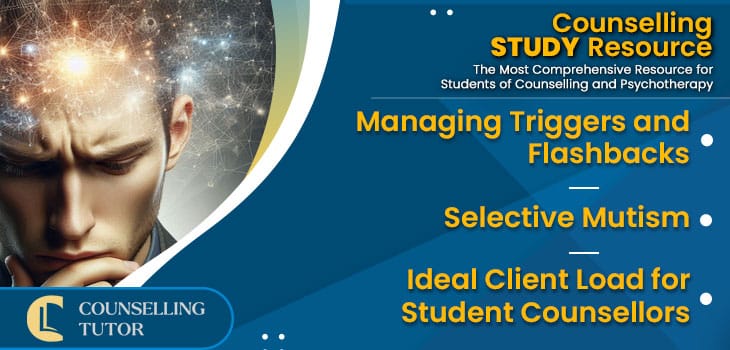See Counselling Skills Used in Real Sessions by Qualified Therapist
Real Sessions – Real Presentations – Real Skills
Gain the competence and confidence to use counselling techniques effectively!

In Episode 334 of the Counselling Tutor Podcast, your hosts Rory Lees-Oakes and Ken Kelly guide us through this week’s three topics:
Managing Triggers and Flashbacks
Managing triggers and flashbacks is crucial for working with clients who have experienced trauma. In this section, Rory and Ken explore the mechanisms behind trauma responses and how counsellors can help clients manage and reduce distress caused by these experiences.
Key points discussed include:
Key Practice Tip:
If a client regularly experiences triggers or flashbacks, therapists should incorporate trauma-informed practices into their approach to ensure a safe and supportive therapeutic environment.

Real Sessions – Real Presentations – Real Skills
Gain the competence and confidence to use counselling techniques effectively!
In ‘Practice Matters’, Rory speaks with Dr. Antje Bothin, author of Annika and the Treasure of Iceland, about selective mutism – a condition where individuals experience extreme anxiety when speaking in certain situations.
The key points discussed include:
Key Practice Tip:
Understanding selective mutism is crucial for counsellors who work with neurodivergent or anxious clients. Therapists should consider specialised training or reading resources such as The Selective Mutism Resource Manual by Maggie Johnson and Alison Wintgens.
Key points from the conversation include:
Key Practice Tip:
Understanding selective mutism is crucial for counsellors who work with neurodivergent or anxious clients. Therapists should consider specialised training or reading resources such as The Selective Mutism Resource Manual by Maggie Johnson and Alison Wintgens.

On-demand access to a rich lecture library covering theory, skills, and professional development for counselling students—Mapped to the UK awarding body criteria
“The Student Library has been BRILLIANT, I can’t recommend it enough!
It has been a lifeline in helping me prepare for practice and my first clients. If you’re considering it, go-for-it, it’s absolutely worth it!”
Kelly – Graduated and now in practice.
In Student Services, Rory and Ken discuss the ideal client load for student counsellors in placement. Many students wonder how many clients they should take on to meet the required placement hours without becoming overwhelmed.
Key points discussed include:
Key Practice Tip:
It’s not a race – each student’s journey is different. Prioritise quality over quantity to ensure you gain the best learning experience while maintaining self-care.
Managing Triggers and Flashbacks

Get on-demand Certified CPD that is implementable in your practice
